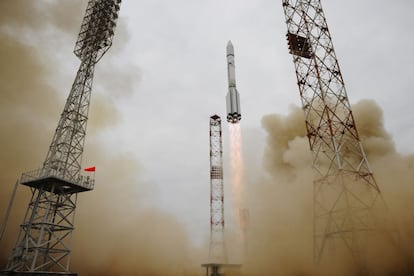A Mars landing ‘made in Spain’
A Spanish-designed shock absorber and heat shield will be key to a European mission to the Red Planet

October 2016, the atmosphere above Mars: ExoMars, a joint European and Russian astrobiology project, has just reached its destination and is preparing for the most delicate part of the mission.
The descent module Schiaparelli enters the nearly non-existent Martian atmosphere at a speed of 21,000 km/h. The friction generates temperatures that would be hot enough to fry the spacecraft if it were not equipped with a heat shield able to withstand 1,750ºC. This shell also serves to slow the craft down.
The ExoMars mission, which is costing €1.3 billion, required the development of new technologies to which seven Spanish companies have contributed
Three minutes later, an enormous 12-meter-wide parachute opens. When the lander is at an altitude of around 1,200 meters, its retro-propellers kick in and slow it down almost to a stop. As the unit hovers over the Martian surface, the propellers turn off and the lander drops suddenly from two meters above ground level.
And this is where the hard part begins.
To ensure that the module does not land face down, rendering it useless, designers had to come up with a structure able to absorb the shock of the impact against the hard, rocky soil of Mars.
“The inside of the material has a honeycomb-like structure; when it receives the impact, it crushes, which is key because that way we prevent the module from bouncing off the ground, being knocked over or thrown off course,” says Eduardo Urgoiti, air and space project director for Sener, the Spanish company that developed this and other components for ExoMars.

In order to create the system, it was first necessary to recreate the pressure and atmosphere found on Mars in a vacuum chamber that also contained rocks and sand similar to those on the Red Planet. The impact was rehearsed several times until the experiment reached a degree of certainty acceptable to the engineers.
“There is a 99% probability that everything will go well,” explains Urgoiti.
The heat shield, made of carbon fiber, was also partly designed and made in Spain, this time by Airbus. The aerospace company has developed a new production system exclusively for this component, which is crucial because “any deformation would make the lander go off course during its descent,” explains Carlos Samartín, head of composite materials at Airbus.
The ExoMars mission, which is costing €1.3 billion, required the development of new technologies to which seven Spanish companies have contributed.
The Schiaparelli will have a short life – two to four Martian days – because its main goal is to test the landing technology. Meanwhile, ExoMars’ second module, the Trace Gas Orbiter (TGO), will map methane sources on the planet.
This will be the first mission able to find the sources of methane and the mechanisms by which it seeps out
Miguel Ángel López, Astrophysics Institute of Andalusia
“It will take a year to reach the final orbit,” says Miguel Ángel López, a researcher at the Astrophysics Institute of Andalusia (IAA). He and other scientists at the center helped design and develop all the electronics in the Nomad gas detector, one of the four instruments aboard the TGO.
Two missions – one in 2004 and another 2014 – have detected methane sources on Mars. The discovery came as a surprise, as nobody expected to find a gas that, on Earth at least, is nearly always associated with the presence of life.
“This will be the first mission able to find the sources of methane and the mechanisms by which it seeps out,” explains López.
The mission has suffered several major setbacks, such as the US decision to pull out, although Russia has since joined the project, allowing the European Space Agency to carry on with the plans. López says Spanish contributors to the project have also experienced problems of their own, as funding for the IAA team has been frozen since 2012.
English version by Susana Urra.
Tu suscripción se está usando en otro dispositivo
¿Quieres añadir otro usuario a tu suscripción?
Si continúas leyendo en este dispositivo, no se podrá leer en el otro.
FlechaTu suscripción se está usando en otro dispositivo y solo puedes acceder a EL PAÍS desde un dispositivo a la vez.
Si quieres compartir tu cuenta, cambia tu suscripción a la modalidad Premium, así podrás añadir otro usuario. Cada uno accederá con su propia cuenta de email, lo que os permitirá personalizar vuestra experiencia en EL PAÍS.
¿Tienes una suscripción de empresa? Accede aquí para contratar más cuentas.
En el caso de no saber quién está usando tu cuenta, te recomendamos cambiar tu contraseña aquí.
Si decides continuar compartiendo tu cuenta, este mensaje se mostrará en tu dispositivo y en el de la otra persona que está usando tu cuenta de forma indefinida, afectando a tu experiencia de lectura. Puedes consultar aquí los términos y condiciones de la suscripción digital.
More information
Últimas noticias
The complicated life of Francesca Albanese: A rising figure in Italy but barred from every bank by Trump’s sanctions
From digital curfews to blocking apps: How technology experts protect their children online
Why the price of coffee has skyrocketed: from Brazilian plantations to specialty coffee houses
Confined to a Cuban hospital: When electricity is a matter of life or death
Most viewed
- Pablo Escobar’s hippos: A serious environmental problem, 40 years on
- Why we lost the habit of sleeping in two segments and how that changed our sense of time
- Trump’s obsession with putting his name on everything is unprecedented in the United States
- Charles Dubouloz, mountaineering star, retires at 36 with a farewell tour inspired by Walter Bonatti
- The Florida Keys tourist paradise is besieged by immigration agents: ‘We’ve never seen anything like this’











































